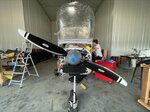Gulf Shores High School is taking students to new heights with a state-of-the-art aviation program, which is currently in the process of extending to the elementary and middle school. Haley Kellogg, …
This item is available in full to subscribers.
Please log in to continue |


Gulf Shores High School is taking students to new heights with a state-of-the-art aviation program, which is currently in the process of extending to the elementary and middle school.
Haley Kellogg, aviation teacher, said she was a student at Gulf Shores High School where she was locally trained before moving back to Gulf Shores to assist in starting the program.
"I flew planes in Alaska and Hawaii, and when we moved back Matt Akin [Gulf Shores City Schools superintendent] met with me and my husband to talk about starting the program," Kellogg said. "I told him I didn't have any teaching experience, but he wanted to hire me for the STEM-based aviation program along with the Tango Flight program. Right now, I only teach the Tango program, which is more hands-on with the kids every day."
The Tango Flight program is an educational, nonprofit organization that blends traditional classroom learning with hands-on training.
"We meet every day at the airport [Jack Edwards International Airport], for 90 minutes and have been working for over two years to build a plane," Kellogg said. "We should have the plane finished this semester. There were several delays due to COVID-19 and a delay in receiving parts."
While the program is open to ninth-12th graders, Kellogg said the idea for the Tango program is to open it only to 11th and 12th graders to keep the classes smaller and require students to take the STEM-based course first to ensure that every student has a basic knowledge of aviation.
"This class attracts a lot of people, so it's hard to keep your classes small," Kellogg laughed. "The idea is that students can go through the build process starting in their junior year, and by the time they finish high school they have helped build a plane."
Kellogg said that in addition to building a plane, students have the opportunity to work on getting their private pilot license and can log flying hours through the program's FAA-approved flight simulator.
"I'm a certified flight instructor, so kids who want to fly in it [the simulator] can actually log hours toward their pilot license," Kellogg said, "It's very beneficial for them to come in and sit in a simulator. They can practice without having to start up an engine and burn money. These kids have a huge leg up. They can't log all of their hours, but they can get a head start on getting their license."
Kellogg said that so far she has had four students obtain their private pilot licenses while working through the program, with one student now working toward his commercial pilot license.
Jessica Sampley, career tech coordinator, said the school system recently received a grant that will be used to purchase a similar flight simulator for the elementary and middle school as well.
"We received the ALSDE CTE Middle Grades Innovation Grant, and the project is called 'Sustainability: Full STEAM Ahead' to introduce students all the way down to fifth grade to career tech opportunities," Sampley said. "The simulators in the lower grades will be used in the STEAM lab at the elementary school and in our 21st century after school care program."
"These kids don't realize that they will have a huge leg up," Kellogg said. "Most pilots these days didn't have access to this in middle or elementary school. They didn't get exposed to any sort of flying experience until after college, so these kids will be way ahead of the curve."
Kellogg said in a typical class day, students will work on weekly tasks related to building the plane and are able to work with mentors, usually retired pilots or mechanics who worked in the aviation field.
"It's really neat to see these kids come through who may have started with no experience working with tools and seeing them get excited being surrounded by the planes at the airport," Kellogg said. "They are also getting experience in a simulated professional environment, and we have even been able to get a few students internships working at the airport while still in high school."